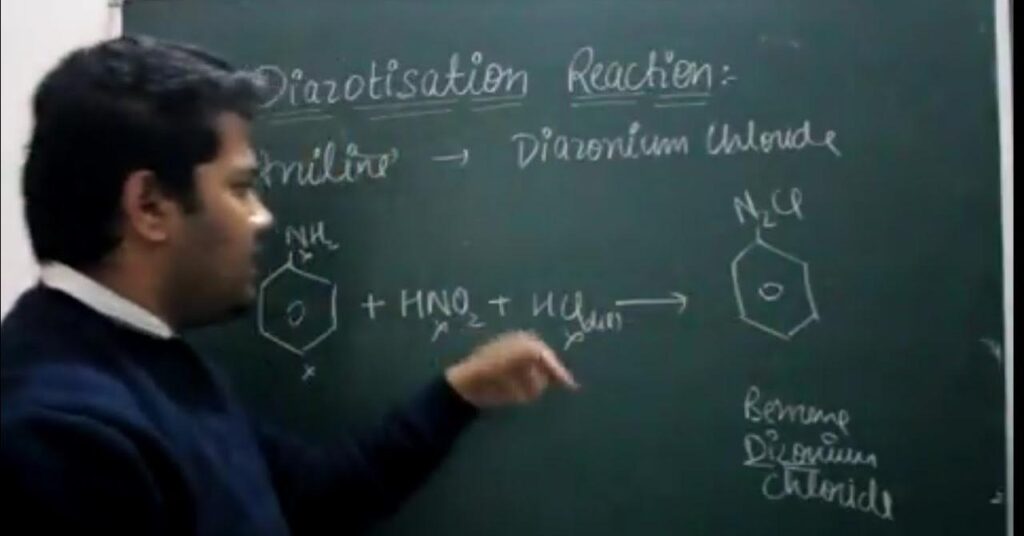Are you curious to know what is diazotization? You have come to the right place as I am going to tell you everything about diazotization in a very simple explanation. Without further discussion let’s begin to know what is diazotization?
Diazotization, often referred to as diazotization reaction, is a fascinating and vital chemical process that involves the conversion of primary aromatic amines into diazonium salts. This reaction holds significant importance in various fields of chemistry, including organic synthesis, pharmaceuticals, and the dye industry. In this blog post, we will delve into the world of diazotization, exploring its mechanism, applications, and its role in shaping the chemical landscape.
What Is Diazotization?
Diazotization is a chemical reaction that involves the conversion of primary aromatic amines (compounds containing an amino group, NH2, attached to an aromatic ring) into diazonium salts (compounds containing the diazonium group, N2+). The reaction is typically carried out by treating the amine with a source of nitrous acid (HNO2) under controlled conditions.
Key Components Of Diazotization:
- Primary Aromatic Amines: These are organic compounds containing an amino group (NH2) attached to an aromatic ring, such as aniline (C6H5NH2).
- Nitrous Acid (HNO2): Nitrous acid is the key reagent used to carry out diazotization. It is often generated in situ by reacting sodium nitrite (NaNO2) with a strong acid like hydrochloric acid (HCl).
- Cold Temperature: Diazotization reactions are typically conducted at low temperatures, often near freezing point, to minimize unwanted side reactions.
The Mechanism Of Diazotization
The diazotization reaction involves a series of steps, with the formation of a diazonium salt as the primary goal. The mechanism can be summarized as follows:
- Generation of Nitrous Acid: Sodium nitrite (NaNO2) is reacted with a strong acid (usually HCl) to produce nitrous acid (HNO2) in situ.
- Formation of the Diazoamine: The primary aromatic amine (e.g., aniline) reacts with nitrous acid to form a diazoamine intermediate. In this step, the amino group (NH2) of the amine is converted into a diazonium group (N2+).
- Isolation of the Diazonium Salt: The diazoamine intermediate is unstable and prone to decomposition. To isolate the diazonium salt, it is often reacted with a cold solution of an inorganic salt, such as sodium tetrafluoroborate (NaBF4), to form a stable diazonium salt.
Applications Of Diazotization
Diazotization reactions have a wide range of applications in the field of chemistry and various industries:
- Organic Synthesis: Diazotization is commonly used in organic synthesis to introduce the diazonium group, which serves as a versatile intermediate for the preparation of various organic compounds, including azo dyes, pharmaceuticals, and agrochemicals.
- Azo Dye Synthesis: The diazonium salts produced through diazotization are essential for the synthesis of azo dyes. Azo dyes are widely used in the textile, food, and cosmetic industries for their vibrant colors.
- Pharmaceuticals: Diazotization is employed in the synthesis of pharmaceutical compounds and intermediates. It allows for the introduction of specific functional groups into drug molecules.
- Photography: In the early days of photography, diazonium salts were used in light-sensitive compounds to capture and develop images. Though largely replaced by modern photographic techniques, this application played a crucial role in the history of photography.
Conclusion
Diazotization is a remarkable chemical reaction that has left an indelible mark on various fields of chemistry and industries. Its ability to convert primary aromatic amines into diazonium salts has paved the way for the synthesis of diverse organic compounds, azo dyes, pharmaceuticals, and more. As chemistry continues to evolve, diazotization remains a fundamental and versatile tool in the hands of chemists, contributing to the development of new materials and innovations.
FAQ
What Do You Mean By Diazotization?
What is Diazotization? The chemical process used in converting a primary aromatic amine into the corresponding diazonium salt of the amine is commonly referred to as diazotization.
What Is Diazotisation Class 12?
Diazotization: The process of conversion of a primary aromatic amino compound into a diazonium salt is known as diazotization. This process is carried out by adding an aqueous solution of sodium nitrite to a solution of primary aromatic amine (e.g., aniline) in excess of HCl at a temperature below 5°C.
What Is Diazonium Reaction?
The diazonium ion reacts with the water in the solution and phenol is formed – either in solution or as a black oily liquid (depending on how much is formed). Nitrogen gas is evolved. This is the same reaction that you get if you react phenylamine with nitrous acid in the warm.
What Is The Diazotization Test Used For?
Nitrous acid (HNO2 or HONO) reacts with aliphatic amines in a fashion that provides a useful test for distinguishing primary, secondary and tertiary amines.
I Have Covered All The Following Queries And Topics In The Above Article
What Is Diazotization Class 12
What Is Diazotization In Chemistry
Diazotization Reaction
What Is Diazotization Give An Example
Diazotization Reaction Pdf
What Is Diazotization Titration
What Is Diazotization Discuss Its Mechanism
Diazotization Reaction Equation
What Is Diazotization
What is the process of diazotization?






